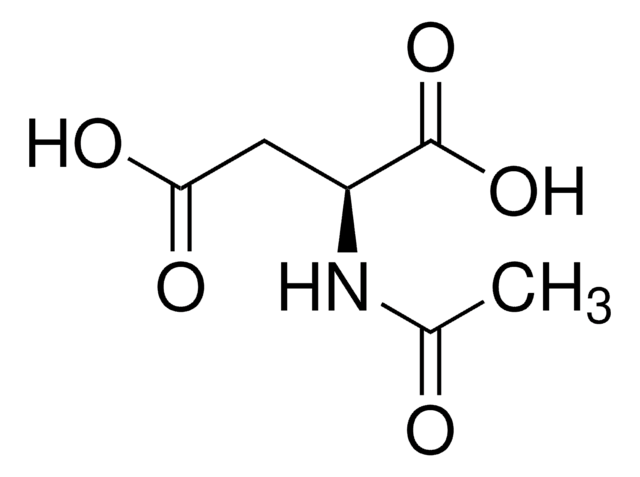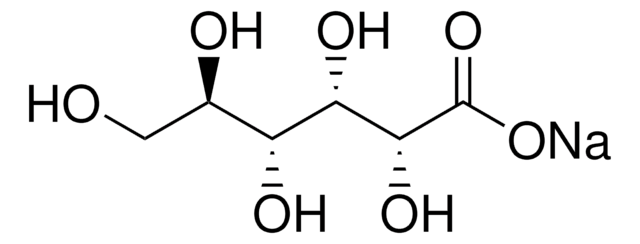推薦產品
一般說明
Aspartic acid (or aspartate) is a non-essential amino acid, which means that it is naturally synthesized by mammals. Aspartate presents many biochemical roles:
In the L-conformation, aspartic acid is a building block in the production of proteins, as well as aiding in many bodily functions, including the urea cycle, gluconeogenesis, and Krebs Cycle, a process that generates adenosine triphosphate (ATP). Aspartic acid also works as a neurotransmitter. The D-Aspartate conformation is linked to neurogenesis and endocrine systems.
In the L-conformation, aspartic acid is a building block in the production of proteins, as well as aiding in many bodily functions, including the urea cycle, gluconeogenesis, and Krebs Cycle, a process that generates adenosine triphosphate (ATP). Aspartic acid also works as a neurotransmitter. The D-Aspartate conformation is linked to neurogenesis and endocrine systems.
應用
The Aspartate Metabolite Library is a kit that contains a selection of 23 metabolite involved in Aspartate metabolism.These may be used for general research, as reagents or as reference compounds in analytical procedures.
生化/生理作用
Aspartate roles and metabolites:
- Aspartate is synthesized by transamination of oxaloacetate through the actions of Aspartate aminotransferase and pyridoxal 5′- phosphate. Aspartyl-tRNA synthase can then couple the aspartate to aspartyl tRNA for protein synthesis.
- Aspartate carries the reducing equivalents in the mitochondrial Malate-Aspartate shuttle, which uses the ready interconversion of aspartate and oxaloacetate.
- N-acetylaspartate synthase, present in the cytoplasm, converts aspartate to N-acetylaspartate, a brain metabolite that regulates dopamine.
- Asparagine is biosynthesized by Asparagine synthetase from aspartate, glutamine, and ATP. Asparagine is involved in the metabolic control of cell functions in nerve and brain tissue.
- Arginosuccinic acid is synthesized from aspartate, citrulline and ATP through the action of Argininosuccinate synthase, one of the enzymes of the urea cycle. In this metabolic pathway, neurotoxic ammonia, produced by protein catabolism, is converted into urea in the liver.
- Fumaric acid is synthesized from Argininosuccinic acid via an Argininosuccinate lyase, which is an enzyme in the Citric Acid Cycle.
- Inosinic acid, aspartic acid and GTP are interconverted to GDP and AMP by the Adenylosuccinate synthetase isozyme 1. This process is involved in the purine nucleotide cycle which regulates nucleotides levels in various tissues.
- Aspartate transcarbamoylase catalyzes the synthesis of N-carbamoyl-L-aspartate from carbamoyl phosphate and aspartate that are involved in the de novo biosynthesis of pyrimidines.
- Beta alanine is formed by decarboxylation of aspartate by Glutamate decarboxylase 1 in the cytoplasm.
- L-aspartate is converted to D-aspartate through the action of a D-aspartate racemase. D-aspartate contributes to the synthesis and release of glucocorticoids, prolactin, oxytocin, and steroids. D-aspartate plays an important role in the brain activity of mammals.
成分
Contains 10 mg each of Aspartate metabolism metabolite standards packaged individually.
套裝中的組件也可單獨購買
產品號碼
描述
SDS
- A2252Adenosine 5′-monophosphate monohydrate, from yeast, ≥97%SDS
- A2383Adenosine 5′-triphosphate disodium salt hydrate, Grade I, ≥99%, from microbialSDS
- A5707Argininosuccinic acid disodium salt hydrate, ≥80%SDS
- 146064β-Alanine, 99%SDS
- C4135Carbamyl phosphate disodium salt, ≥80%SDS
- C7629L-Citrulline, ≥98% (TLC)SDS
- 219096D-Aspartic acid, ReagentPlus®, 99%SDS
- F6625Flavin adenine dinucleotide disodium salt hydrate, ≥95% (HPLC), powderSDS
- 47910Fumaric acid, ≥99.0% (T)SDS
- G7252Guanosine 5′-diphosphate tris salt from Saccharomyces cerevisiae, Type VI, ≥92.5%SDS
- G9002Guanosine 5′-triphosphate tris salt, ≥93% (HPLC), powderSDS
- I2879Inosine 5′-monophosphate from Saccharomyces cerevisiae, ≥98%SDS
- A5006L-Arginine, reagent grade, ≥98%SDS
- A0884L-Asparagine, ≥98% (HPLC)SDS
- 11189L-Aspartic acid, BioUltra, ≥99.5% (T)SDS
- G1251L-Glutamic acid, ReagentPlus®, ≥99% (HPLC)SDS
- G3126L-GlutamineSDS
- 00920N-Acetyl-L-aspartic acid, ≥99.0% (T)SDS
- O4126Oxaloacetic acid, ≥97% (HPLC)SDS
- K1750α-Ketoglutaric acid, ≥98.5% (NaOH, titration)SDS
- P9255Pyridoxal 5′-phosphate hydrate, ≥98%SDS
- P8010Sodium pyrophosphate tetrabasic, ≥95%SDS
- 69037Ureidosuccinic acid, 98.0-102.0% (T)SDS
查看全部 (23)
訊號詞
Danger
危險聲明
危險分類
Acute Tox. 4 Oral - Eye Dam. 1
儲存類別代碼
11 - Combustible Solids
分析證明 (COA)
輸入產品批次/批號來搜索 分析證明 (COA)。在產品’s標籤上找到批次和批號,寫有 ‘Lot’或‘Batch’.。
Pyrimidine Biosynthesis
Lennarz W J, et al.
Encyclopedia of Biological Chemistry, 600-605 (2004)
我們的科學家團隊在所有研究領域都有豐富的經驗,包括生命科學、材料科學、化學合成、色譜、分析等.
聯絡技術服務









